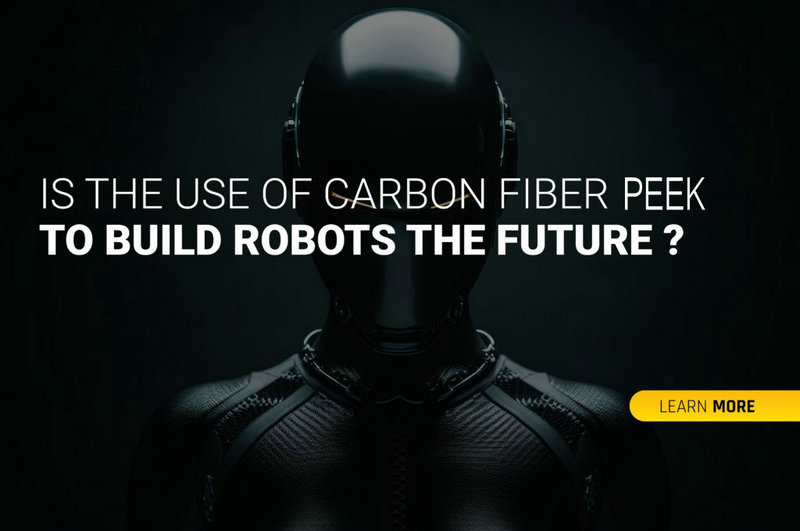
Carbon fiber reinforced PEEK (PEEK-CF) is a high-performance composite material that combines the excellent properties of PEEK resin—such as high-temperature resistance, chemical resistance, and creep resistance—with the lightweight, high-strength, and stiffness of carbon fiber. In the field of humanoid robotics, these unique characteristics make PEEK-CF ideal for use in key components. Here's how it excels:
Background:
Humanoid robots must mimic human movement, demanding highly lightweight joints and skeletal structures to reduce inertia, improve response speed, and extend battery life.
PEEK-CF Advantage:
Density: Only 1.4–1.6 g/cm³ (about half that of aluminum alloy)
Comparable strength to metals: Tensile strength of 200–300 MPa and modulus over 20 GPa
Applications:
Used in robot skeletons, joint linkages, and support frames to reduce overall weight and improve motion efficiency.
Background:
Robot joints endure high-frequency dynamic loads and require dimensional stability to maintain precision without deformation.
PEEK-CF Advantage:
Low thermal expansion coefficient: 2–5×10⁻⁶/K, suitable for metal bearing integration
Self-lubricating: Low friction coefficient (0.2–0.3), reduces dependence on lubricants
Applications:
Ideal for gears in reducers, harmonic drive parts, and rotary joint bearings.
Background:
Integrated high-power motors and electronics inside robots can reach temperatures over 150°C, which deforms traditional plastics.
PEEK-CF Advantage:
Continuous operating temperature: Up to 250°C (short-term tolerance to 300°C)
Electromagnetic shielding: Conductive due to carbon fibers, surface resistivity down to 10²–10⁴ Ω/sq
Applications:
Used in motor housings, controller casings, and heat dissipation brackets.
Background:
Bionic robots require flexible structures (e.g., fingers, spines) that combine flexibility with fatigue resistance.
PEEK-CF Advantage:
High fatigue strength: Over 80% strength retention after 10⁷ load cycles
Tunable stiffness: Adjustable by carbon fiber content (30%–50%) and fiber orientation
Applications:
Flexible robotic fingers, bionic spine modules, and foot damping components.
Background:
Service robots may encounter corrosive environments with cleaning agents or oil, while moving parts face significant wear.
PEEK-CF Advantage:
Chemical resistance: Resistant to acids, alkalis, and organic solvents (except strong oxidants like concentrated sulfuric acid)
Wear resistance: Over 50% better than unreinforced PEEK, PV value up to 3 MPa·m/s
Applications:
Exoskeleton protective layers and wear-resistant coatings for industrial robot grippers.
Boston Dynamics' Atlas Robot: Though material details are not disclosed, the hydraulic system’s high-pressure environment (>20 MPa) and lightweight requirements align well with PEEK-CF properties.
Commercial Cost Comparison: PEEK-CF material costs $200–300/kg with high machining costs. However, its service life is 2–3 times that of metal parts, resulting in potentially lower lifecycle costs.
Machining Difficulty: PEEK-CF requires high-temperature injection molding (melting point >370°C), and carbon fibers wear down molds.
Solution: Use hardened mold steels (e.g., H13) and laser sintering technologies.
Recycling Issues: While thermoplastic PEEK is recyclable via hot pressing, separating carbon fibers is difficult.
Trend: Development of biodegradable PEEK matrices or closed-loop recycling systems.
3D Printing Applications: Short carbon fiber-reinforced PEEK filaments are now used in FDM printing, enabling complex biomimetic lattice structures.
Smart Material Integration: With carbon fiber’s conductivity, self-sensing structures can be developed for real-time monitoring of strain and temperature.
Carbon fiber reinforced PEEK is solving the limitations of traditional metals and plastics in humanoid robots through its lightweight, high-temperature resistance, and high-precision capabilities. While cost and processing present challenges, advancements in 3D printing and recycling technologies are accelerating its adoption. PEEK-CF is emerging as a key material in building high-performance, durable, and responsive humanoid robots.